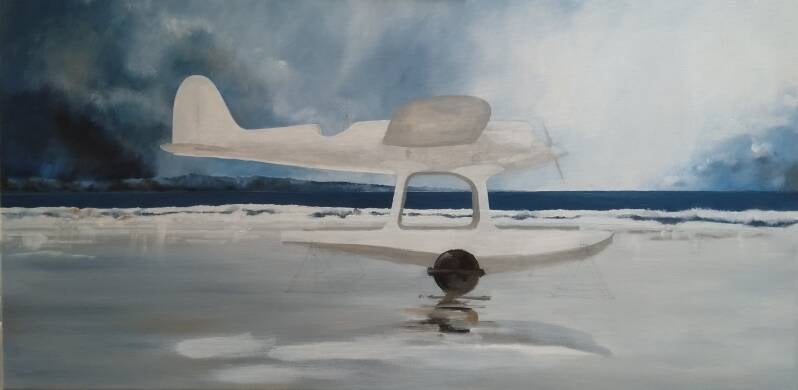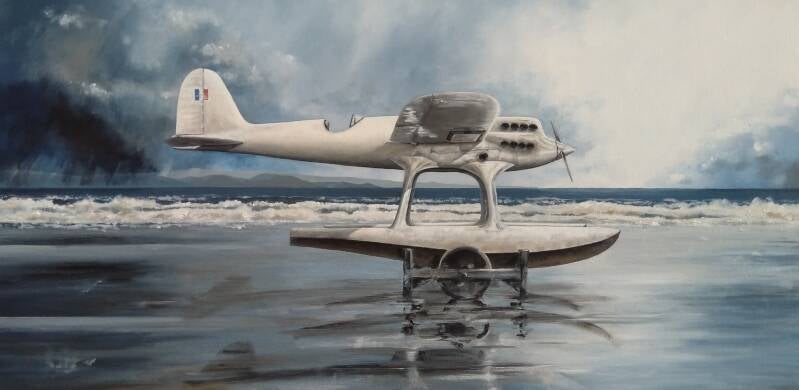The stages below take one of my recent paintings and shows the structured thinking and compositional stages I typically worth through. And in this case, reveals some of the history behind the subject.
Supermarine S4. Acrylic on canvas. 40(h) x 80(w) cm
This painting is a story about a time in history where there was stupendous and bewildering growth in design and technology, set in a mixed context of sadness, aspiration and a growing threat that would ultimately draw in all of humanity: The 1920s.
The subject is a Supermarine S4 aircraft. Only 1 was built. It was the British entry to the Schneider Trophy sea plane speed race in 1925. The aim was to take off and land on sea, and to transit a set course as fast as possible.
For context, consider that less than 10 years before this, pilots fought in tiny biplanes made of larch, wire and canvas with the Wright brothers first having powered an aircraft just 22 years before in 1903. Cars still needed to be hand-cranked to start them, gas lighting was still prevalent and Fleming would have to wait until 1928 to discover penicillin.
Yet in the S4, a single person had the power of 680 horses at the pull of a lever, whilst strapped into a sleek metal craft capable of over 226mph. Only one other aircraft was faster - the Curtiss R3C-2, flown in the same race. These were, at that time, the fastest machines ever made by human kind. No human in all of history had ever travelled faster.
This painting is essentially a triptych. Arranged with a vertical double square on both left and right holding secondary topics setting the primary topic in the large central square.
The composition represents three historical times with a clockwise movement of the eye from lower left, up and over the subject to the bright white sky, then back under and to the left following the sweeping lower curve of the sea floats. WW1 is in the past on the left represented by a retreating storm. Its effects still apparent as fractured reflections on wet ground. WW2 approaches on the right as a coming storm, beyond the bright white of 'hope'.
The canvas is further divided into upper and lower elements. The aircraft taking the role of a mythical ethereal object above the horizon - untouchable. Set motionless against the middle of the sky and pointing into the future - its nose cone in the white of 'hope'. Its upper edge is tonally dramatic. It is uninterrupted by foreground topics and motionless against the turbulent sky, thus emphasising the mood of calm courage in a setting of turmoil.
The S4 is seen stable and side on. The emotion created is one of being captivated by an alien object, reminiscent of the occupants of Troy waking to the Trojan Horse. Meanwhile the events of time and transient people wash past to the perpetual sound of breaking waves. At the time, the Supermarine S4 was the ultimate human achievement: A materialisation of ability, ingenuity, aspiration and potential.
Hints of militarism in the human figures show both the recently past conflict and an inquisitive pondering of the technology's possible influences on the future - its ultimate derivative being the Supermarine Spitfire.
This painting will be 1 of 3, each using Supermarine seaplanes as subjects. All will have 'narrative' as the framework for composition, application of colour and tonal drama.



Create Your Own Website With Webador